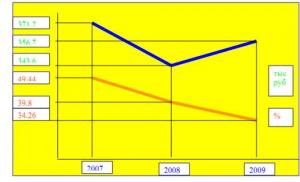Collets for automatic lathes. Collet chuck for a machine: types, design, principle of operation
A device such as a collet chuck is a type of clamping mechanism used to secure a cutting tool rotating at high speed. Unlike quick-release chucks, collet chucks do not require the use of additional devices such as screws, pins or locking elements, which is why such devices are often called self-clamping.
Collet-type clamping elements are equipped with chucks for a lathe, in which parts are fixed during processing. Such chucks, depending on the geometric parameters of the workpiece being processed, may differ in both their dimensions and the shape of the clamping elements. The most common of all those used today are collet clamps of the ER type.
Main varieties
To complete modern metalworking machines (lathes, milling and drilling), self-centering chucks are used, equipped with two, three or four jaws. The clamping elements in such chucks can be operated manually or using a mechanical drive. If we talk about the areas of application of such clamping mechanisms, then two-jaw chucks are used primarily for fixing shaped castings during their processing, and with the help of three-jaw clamping mechanisms, reliable fastening of workpieces and tool shanks of round, conical and hexagonal shapes is ensured. Clamping mechanisms equipped with four jaws are used in cases where processing requires fixing an asymmetrical workpiece or a rectangular part.

In general, all mechanisms for fixing a tool or workpiece during processing are divided into the following categories:
- collet type devices;
- lever devices;
- quick-clamping type devices (BZP);
- wedge clamping devices;
- hydraulic chucks;
- membrane clamps;
- thermal cartridges;
- two-, three- and four-jaw clamping devices.
Self-clamping chucks, which use a collet mechanism, are needed to equip both specialized and universal machines. The advantage of using chucks of this type is that their design provides sufficient clamping force even with a small torque value, which cannot be said about similar devices of other types. When choosing a collet chuck, you should pay attention to the fact that the main elements of its design are made of hardened steel. In this case, it can last much longer.
How does the collet clamping mechanism work?
A milling or turning chuck, the basis of which is a collet clamp, works according to the following principle:
- A self-tightening nut, which is tightened, creates pressure on the end of the collet mechanism.
- Under the influence of pressure, the collet moves into a cone-shaped hole, which leads to compression of the petals that make up its working part.
- By contracting, the collet blades securely fix the tool shank or workpiece.

Accordingly, in order to remove a tool or workpiece from such a chuck, it is necessary to loosen the self-clamping nut, reducing the pressure it exerts on the collet.
The big advantage of collet chucks for a milling machine (or turning equipment), when compared with similar devices of other types, is that the tool or workpiece that is fixed in them is perfectly centered, which ensures minimal radial runout. In addition, to use a collet-type milling or lathe chuck, there is no need to use special keys, which, as a rule, are often lost.

Collet chucks can be used to hold parts whose cross-sectional configuration does not match the shape of their entry hole. In order to fix such a part in a collet chuck, special cartridges are used, supplied with the device.
Design features
The main design elements of any collet chuck are the clamping nut and the collet clamping mechanism, which can be retractable, retractable or stationary. Depending on their purpose, collet mechanisms can be clamping or feeding. Collet-type mechanisms are also used to fix workpieces along the surface of their internal hole. This fixation is ensured by a special device – a collet mandrel. In addition to fixing parts during processing, a collet mandrel can be used to secure attachment-type cutters to it.

Feeding collet mechanisms are used in cases where the part fixed in them during processing must be periodically pulled out of the clamping device. The design of such a collet consists of a steel bushing, on the side surface of which three cuts are made, forming spring clamping petals, as well as a tube through the inner hole of which the workpiece is fed into the processing zone. Before using such a mechanism, the collet sleeve is screwed into a threaded hole in the tube, and the end of the workpiece is passed between the blades of the clamping mechanism. A special rod driven by a cam or hydromechanical mechanism is responsible for feeding the workpiece into the processing zone.

The clamping collet, which is also made in the form of a sleeve with spring petals, provides only fixation of the workpiece, without feeding it into the processing area. Depending on the diameter of the tool shank or the workpiece being processed, which are fixed using a collet mechanism, the number of petals may vary. Thus, for fixing tools and workpieces with a diameter of no more than 3 mm, three-lobe collets are used, with a diameter from 3 to 80 mm - four-lobe collets, and with a diameter of more than 80 mm - six-lobe collets.
To fix tools and workpieces of the smallest diameter, split clamping collets are needed, the design of which contains special springs responsible for opening the jaws. Collets of this type can be additionally equipped with inserts selected depending on the diameter of the tool or workpiece.

Collet chucks, the design of which is complemented by another nut, can be used to fix small-diameter tools with a Morse cone-shaped shank. The disadvantage of this type of collet is that for tools of different diameters it is necessary to use a separate clamping mechanism.
Turning of small-diameter workpieces, performed on longitudinal type machines, can also be performed using collet clamping mechanisms. Collet chucks used in such cases differ in their design from conventional models.
The first thing you should pay attention to when choosing a collet-type chuck is how the device is secured to the spindle of the equipment you are using. There can be two options for such fastening: using a special adapter or screwing the chuck onto the threaded end of the spindle. If a collet-type milling or lathe chuck will be connected to the machine spindle using a flange or Morse taper, you must first find out their exact parameters (belt diameter and taper parameters).
As mentioned above, depending on the diameter of the tool shank or the workpiece being processed, the number of clamping elements with which the collet is equipped is selected. In addition, you should pay attention to the material from which such elements are made: the harder it is, the longer the cartridge will serve you.
3. Collets for feeding and clamping the bar
In automatic lathes, the extension (feed) and clamping of the bar are carried out using a mechanism, the essential links of which are the feed and clamping collets.
Fig. 91. Collet for extending the rod.
The feed collet is a split sleeve, the jaws of which were in a compressed state during heat treatment (Fig. 91). The elasticity of its jaws should ensure clamping of the rod with a force sufficient to move it in the axial direction when the clamping collet is open.
At the same time, the elastic force of the feed collet jaws should not be too great, since the feed collet should slide along the bar, moving to its original position, while the bar is held by the clamping collet. The feed collet and feed pipe have threaded connection
. When the bar is clamped by the clamping collet, the feed collet, moving backward, slides to its original position. Before feeding, the clamping collet releases the bar, and the feed collet moves forward with it, gripping it with the preload force of the collet. IN Lately Feeding collets with replaceable inserts have been used, which provide them with more rational use
Due to operating conditions, feed collets must have high wear resistance, as a result of which they are usually made of case-hardened steel or steel with a high content of alloying elements.
Automatic clamping of a bar on automatic lathes is carried out using a clamping collet placed at the front end of the spindle.


Fig. 92. Collet for securing the rod: a - with a diameter of up to 5 mm; b - with a diameter from 6 to 36 mm.
There are various designs of clamping collets and, accordingly, clamping methods.
On revolving automatic machines, collets with a reverse cone were used (Fig. 92). This type of fastening of the rod provides greater rigidity, since the axial cutting force increases the clamping force of the rod by the collet.
The collet can rest against the machine spindle with its front part (Fig. 22, c). In this case, to clamp the rod onto the collet, a sleeve is found, to which a compressive force must be applied. This fastening ensures accurate feeding of the rod, since during the clamping process the collet remains stationary in the axial direction, while the sleeve moves.
The main disadvantage of this rod fastening scheme is the comparative increase in the dimensions of the clamping mechanism.
Three slots are made in the collets for round and hexagonal materials, and four for square ones.
Clamping collets are usually made of steels U8, 9ХС; after hardening, they should have a hardness of the working part RC ~ 58-60, and the hardness of the tail part - RC ~ 38-50.
Recently, collets with transitional replaceable jaws, which are attached to the main body of the collet with screws, have been used. In practice, such collets turn out to be very convenient, since they clamp rods of different diameters with jaws. Thus, a set of collets for different rod diameters is replaced by a set of jaws. In addition, the conditions for heat treatment of collets are improved, since the replaceable jaws are thermally treated independently.
The disadvantage of collets with replaceable jaws is the complexity of the design and slightly reduced rigidity.
Collets used for processing parts that cause low cutting forces usually have a ground hole, so that the surface of the rod at the clamping points does not deteriorate. At high cutting forces, the clamping surface is made corrugated to increase friction between the rod and collet.
The main dimensions of the feed and clamping collets shown in Fig. 91 and 92 are given in table. 35. Table 35 Main Dimensions (in mm) feed and clamping collets used on revolving automatic machines

- This is a special fixing device for installing the tool. It is used as the main element of a collet chuck for clamping a tool or a cylindrical workpiece. Special collets for square or hexagonal shanks are also used.
Design and Application
The collet is a spring-loaded split sleeve with a truncated cone and a hole of the required diameter. The collet body has special cuts that ensure the movement of the locking blades when installing or removing the tool. The compressive force ensures the rotation of the nut.
The figure below shows a collet (1), a straight-shank cutter (2) and a collet chuck (3).

This fixing element is intended for installation in a collet chuck, which, most often, is a separate element of the equipment of a metal-cutting machine. The cartridge itself is installed using a Morse taper on the cartridge seat. He may also be integral part machine
Collets are widely used in modern metal-cutting machines - turning, drilling and milling. The main advantage of this type of fixation is the high speed of installation or removal of the tool. The disadvantages include the need to strictly match the standard sizes of the chuck and collet.
Types of collets
In modern metalworking, various types of collets are used, differing in size and design. General purpose fasteners are divided into:
- Through and blind. Through ones can fix a part of unlimited size and are used, for example, to fix a rod for turning.
- One or two clamping zones. The most rigid fixation is provided by collets with two clamping zones, completely eliminating deviation from the spindle axis.
- Collets for taps and other tools with square or hex shank. The design of this type of clamp provides axial compensation.
Application of collets in lathes

The collet and collet chuck are used as the main fixing equipment when longitudinal processing of small-diameter workpieces is necessary. These devices can be equipped with ceramic or carbide inserts to increase wear resistance and prevent metal sticking.
To work with workpieces on automatic lathes, feed and clamping collets are used. The feeder is used in conjunction with the clamping device and provides sufficient clamping of the workpiece to move in the axial direction, with the second fixing equipment in the open position. This type of collet has a threaded connection to the supply pipe. When the workpiece is held by the clamping rod, the feeder moves back to its original position. Before feeding, the clamping machine releases the workpiece and the feeder moves it forward along with it.
The clamping collet provides automatic clamping of the bar and is located in the front part of the spindle. On turret lathes, collets with a reverse taper are most often used, which provides higher rigidity due to increased clamping force during axial cutting.
GOST standards
GOST 17201-71 applies to clamping type collets intended for cylindrical shanks. Other commonly used standards define the main and connecting dimensions of collets. For clamping collets, GOST 2876-80 applies, for feeders - GOST 2877-80. From international standards Generally applicable is DIN 6499, ISO 15488, which regulates the parameters of ER collets - with two clamping zones and a through hole.













